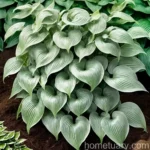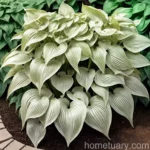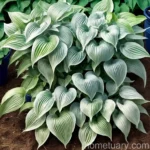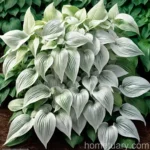All About Narrow-Leaved Hosta (Hosta Lancifolia)
Narrow-leaved hosta (Hosta lancifolia) is a stunning perennial plant that is prized for its elegant foliage and ease of cultivation. In this comprehensive guide, we will explore the key aspects of caring for and growing this beautiful plant. From its cultural requirements to its uses, water and sunlight needs, soil and fertilizer considerations, propagation techniques, and common diseases and pests, we will cover everything you need to know to successfully cultivate and enjoy narrow-leaved hosta in your garden or landscape.
What is Plant: Narrow-Leaved Hosta (Hosta Lancifolia)
Hosta lancifolia, commonly known as narrow-leaved hosta, is a species of hosta that belongs to the Asparagaceae family. Native to north-east Asia, particularly Japan and Korea, this plant is known for its graceful, lance-shaped leaves and its striking appearance, which adds texture and color to shaded areas in the garden. Narrow-leaved hosta is a herbaceous perennial, typically reaching a height of 12-15 inches and a spread of 18-24 inches. It produces attractive lavender blooms in summer, adding another dimension to its ornamental appeal.
This plant is highly valued for its foliage, which comes in various shades of green and often displays beautiful variegations. From bright chartreuse to deep, glossy green, narrow-leaved hosta offers a wide range of colors and textures, making it a versatile and desirable addition to any garden or landscape. Its adaptability to shade makes it an ideal choice for areas with limited sunlight, and its low maintenance requirements make it a popular choice among gardeners and landscapers.
Key Takeaways
In this guide, we will delve into the specific aspects of caring for narrow-leaved hosta, including its cultural needs, uses, water and sunlight requirements, fertilizer and soil considerations, pruning techniques, propagation methods, and insights into its popularity. Additionally, we will explore common diseases and pests that affect this plant, along with botanist’s tips and fun facts. By the end of this comprehensive guide, you will have a thorough understanding of how to cultivate, maintain, and appreciate the beauty of narrow-leaved hosta in various gardening and landscaping settings.
Culture
When it comes to the culture of narrow-leaved hosta, several key factors contribute to the successful cultivation of this plant:
-
Shade Preference: Narrow-leaved hosta thrives in partial to full shade, making it an excellent choice for shaded garden beds, woodland areas, and under the canopy of trees. It is important to provide adequate protection from the intense afternoon sun, especially in regions with hot summers.
-
Moist, Well-Drained Soil: This plant prefers moist, rich soils with good drainage. Amending the soil with organic matter, such as compost or well-rotted manure, can improve its water retention and fertility. However, it is essential to avoid waterlogged conditions, as this can lead to root rot.
-
Hardiness Zones: Narrow-leaved hosta is typically suited to USDA hardiness zones 3-9, although specific cultivars may have different zone preferences. It is important to choose varieties that are well-adapted to your local climate for optimal growth and longevity.
-
Low Maintenance: One of the appeals of narrow-leaved hosta is its low maintenance requirements. While it benefits from regular watering and fertilization, it is generally resilient and able to withstand neglect to some extent. However, providing proper care will ensure healthier and more vibrant foliage.
Uses
Narrow-leaved hosta offers a range of practical and aesthetic uses in garden and landscape settings:
-
Shade Gardens: Its preference for shade makes it an excellent choice for shaded gardens, where it can be paired with other shade-loving plants to create a lush and harmonious display.
-
Ground Cover: Its spreading habit and dense foliage make it an effective ground cover in areas with limited sunlight, where it can create a carpet of greenery and suppress weed growth.
-
Border Planting: When planted in groups or along garden borders, narrow-leaved hosta can create visually appealing borders, complementing other plants and adding texture to the landscape.
-
Container Gardening: This plant can be grown in containers, allowing gardeners with limited space to enjoy its beauty on patios, balconies, or other outdoor areas.
-
Erosion Control: Due to its ability to form dense clumps and spread gradually, narrow-leaved hosta is useful for controlling erosion on slopes or in areas with loose soil.
Water
Adequate water is crucial for the health and vigor of narrow-leaved hosta. While it is important to avoid waterlogged conditions, consistent soil moisture is essential for optimal growth and foliage development. The following guidelines can help ensure proper watering for this plant:
-
Regular Watering: During the growing season, provide regular watering, especially during dry periods, to keep the soil consistently moist. Aim to water deeply, allowing the water to reach the roots.
-
Mulching: Applying a layer of organic mulch around the base of the plant can help retain soil moisture, suppress weeds, and maintain a more stable root zone temperature.
-
Avoid Overhead Watering: When watering narrow-leaved hosta, it is best to avoid overhead watering, as wet foliage can promote the development of fungal diseases. Instead, direct the water to the base of the plant.
Sunlight
Narrow-leaved hosta is renowned for its ability to thrive in shady conditions, making it an ideal choice for areas with limited sunlight. When considering its sunlight requirements, the following points should be taken into account:
-
Partial to Full Shade: This plant performs best in partial to full shade, particularly in regions with hot summers. Inadequate sunlight can result in pale, less vibrant foliage, so it is essential to provide the right balance of light and shade.
-
Filtered Light: While it can tolerate some morning sun, narrow-leaved hosta benefits from filtered or dappled light throughout the day. This can be achieved by planting it beneath tall trees or near structures that provide partial shade.
-
Protection from Afternoon Sun: In locations with intense afternoon sun, it is crucial to protect narrow-leaved hosta from prolonged exposure. Hot, direct sunlight can scorch the leaves and cause stress to the plant.
Fertilizer
Proper fertilization is essential for promoting healthy growth and vibrant foliage in narrow-leaved hosta. By providing the appropriate nutrients, gardeners can support the plant’s development and ensure its longevity. Consider the following tips for fertilizing this plant:
-
Balanced Fertilizer: Use a balanced, slow-release fertilizer with an NPK ratio suited for flowering perennials. A 10-10-10 or 12-12-12 formulation can provide the necessary nutrients without promoting excessive foliage at the expense of blooms.
-
Application Timing: Apply fertilizer in early spring as new growth emerges, and again in early summer to support the plant during its active growth period. Avoid applying fertilizer too late in the season, as this can encourage late, tender growth that is susceptible to winter damage.
-
Even Distribution: Spread the fertilizer evenly around the base of the plant, taking care to avoid direct contact with the foliage. Water the area thoroughly after application to promote nutrient uptake.
Soil
The soil composition and quality play a significant role in the overall health and vitality of narrow-leaved hosta. Light, friable, and moisture-retentive soils are particularly well-suited to this plant, providing an ideal growing medium. Consider the following soil considerations for cultivating this species:
-
Organic Matter: Incorporate organic matter into the soil, such as well-rotted compost, leaf mold, or aged manure, to improve its structure, nutrient content, and water retention capabilities.
-
Acidic to Neutral pH: Aim for a slightly acidic to neutral soil pH range of 6.0 to 7.5, as narrow-leaved hosta prefers soil that is not overly alkaline. Regular soil testing can help monitor and adjust the pH as needed.
-
Good Drainage: Ensure that the soil provides good drainage to prevent waterlogging, as excessively wet conditions can lead to root rot and other issues. Amending heavy or compacted soils can improve drainage and aeration.
-
Moisture Retention: While well-drained soil is important, it is also crucial to maintain adequate moisture levels, especially during hot and dry periods. The addition of organic matter can help enhance the soil’s moisture retention capacity.
Pruning
Pruning narrow-leaved hosta is a straightforward process that involves removing old or damaged foliage, tidying up the plant, and division to control its size and rejuvenate its growth. Proper pruning can help maintain the plant’s vigor and appearance while preventing overcrowding and promoting air circulation. Follow these pruning guidelines for optimal plant care:
-
Spring Cleanup: In early spring, remove any dead or yellowing leaves from the previous season. This helps to rejuvenate the plant and prevents fungal diseases from spreading.
-
Division: Every few years, consider dividing mature clumps of narrow-leaved hosta to maintain their vitality and prevent overcrowding. This can be done in early spring before new growth emerges or in early fall.
-
Snipping Flowers: To redirect the plant’s energy towards foliage production, consider snipping off the flower stalks as they appear, especially if the primary focus is on the foliage rather than the blooms.
-
Tidying Up: Throughout the growing season, remove any spent or unsightly foliage to keep the plant looking neat and tidy. This can also help improve air circulation around the plant.
Propagation
Narrow-leaved hosta can be propagated through various methods, including division, seed sowing, and tissue culture. These techniques allow gardeners to expand their hosta collection, introduce new varieties, or share plants with others. Consider the following propagation methods for this versatile plant:
-
Division: Division is the most common and reliable method of propagating narrow-leaved hosta. It involves separating well-established clumps into smaller sections, each with their own roots and growing points. This is typically done in early spring or early fall.
-
Seed Sowing: While more time-consuming and unpredictable, growing hosta from seed can be an exciting way to explore new genetic variations and develop unique cultivars. Collect ripe hosta seeds and sow them in a suitable growing medium for germination.
-
Tissue Culture: For those looking to propagate hosta on a larger scale or under controlled conditions, tissue culture offers a precise and efficient method. This technique involves the culture of plant cells in a laboratory setting to produce new plants.
-
Root Cuttings: Some gardeners also achieve success with propagating hosta through root cuttings. By taking healthy root sections and providing them with the right growing conditions, new plants can be generated.
Container Popularity
Narrow-leaved hosta’s adaptability to container gardening has contributed to its popularity as a versatile and eye-catching choice for potted displays. Its lush foliage, low maintenance requirements, and shade tolerance make it well-suited to container culture. Consider the following factors when growing narrow-leaved hosta in containers:
-
Container Size: Choose pots or containers that provide ample space for the plant’s root system while allowing for sufficient drainage. Shallow, wide containers are generally preferred for accommodating the plant’s spreading habit.
-
Potting Mix: Use a well-draining, high-quality potting mix that is rich in organic matter and provides good aeration. Avoid compact and heavy soils, as these can impede root development and drainage.
-
Moisture Management: Container-grown narrow-leaved hosta may require more frequent watering, especially during hot and dry periods. Monitor the soil moisture regularly and adjust the watering frequency as needed.
-
Shade and Sunlight: Position the containers in areas that receive filtered or dappled light, particularly if growing them on patios, balconies, or under arbors. Protect them from intense afternoon sun to prevent leaf scorching.
-
Overwintering: In regions with cold winters, consider overwintering container-grown hostas in a sheltered location, such as an unheated garage, to protect them from harsh temperatures and frost.
Common Diseases
Narrow-leaved hosta is generally resilient to diseases, but certain issues can arise, particularly in conditions that promote fungal growth and stress the plant. By identifying and addressing common diseases promptly, gardeners can help protect their narrow-leaved hosta from long-term damage. The following are some of the prevalent diseases that may affect this plant:
-
Leaf Spot: Leaf spot diseases, caused by various fungal pathogens, can lead to the development of dark, water-soaked spots on the foliage. Proper sanitation and the removal of affected leaves can help manage leaf spot.
-
Crown Rot: Excessive soil moisture and poor drainage can contribute to crown rot, a condition in which the plant’s crown and roots become infected and may decay. Improving soil drainage and avoiding overwatering can help prevent crown rot.
-
Slime Flux: Slime flux, characterized by a foul-smelling, dark liquid oozing from the plant’s base, can result from stress, injury, or bacterial infection. Ensuring proper care and minimizing unnecessary damage to the plant can reduce the risk of slime flux.
-
Powdery Mildew: Powdery mildew, a common fungal disease, can appear as a white powdery growth on the leaves, particularly in humid conditions. Good air circulation and the use of fungicidal sprays can help control powdery mildew.
-
Root Rot: Prolonged waterlogged conditions can lead to root rot, affecting the plant’s root system and overall health. Adequate soil drainage and proper watering practices are essential for preventing root rot.
Disease Diagnosis
Effective disease diagnosis involves careful observation and identification of the symptoms and signs present on the plant, as well as an understanding of the prevailing environmental conditions. By considering the following factors, gardeners can make more informed assessments and take appropriate action to address potential diseases affecting narrow-leaved hosta:
-
Fungal Growth: Pay attention to any unusual fungal growth or discoloration on the leaves, stems, or crown of the plant, as these can be indicative of fungal diseases.
-
Leaf Discoloration: Discoloration, spotting, or wilting of the leaves may indicate the presence of pathogens or environmental stressors, prompting further investigation.
-
Soil Conditions: Assess the soil drainage, moisture levels, and overall growing conditions to identify any factors that may contribute to disease development.
-
Previous Health: Consider the plant’s overall health and any recent changes in its appearance or growth, as these may provide clues to underlying issues.
-
Localized Symptoms: Look for localized symptoms such as lesions, cankers, or wet areas on the plant that may signal specific diseases, especially those affecting the root or crown.
By conducting a thorough assessment and seeking professional advice when needed, gardeners can better diagnose and manage diseases affecting narrow-leaved hosta.
Common Pests
While narrow-leaved hosta is relatively resistant to most pests, several common insect pests can occasionally pose a threat to its health and vigor. By identifying and addressing these pests proactively, gardeners can help protect their narrow-leaved hosta from potential damage. Consider the following pests that may affect this plant:
-
Slugs and Snails: These voracious feeders can cause extensive damage to hosta foliage, leaving behind ragged, chewed leaves. Applying slug and snail baits or using physical barriers can help control these pests.
-
Deer: In areas with high deer populations, hostas are often targeted for their lush foliage and may require protection, such as fencing or repellents, to prevent browsing damage.
-
Voles and Rodents: These creatures can cause damage to the plant’s underground parts, including the roots, bulbs, and rhizomes. Avoiding excessive mulch and eliminating hiding spots can help deter voles and rodents.
-
Aphids: While less common, aphid infestations can occur on hosta plants, leading to distorted growth and the production of sticky honeydew. Insecticidal soaps or horticultural oils can help manage aphids.
-
Slime Trail Evidences: Look for slime trails on the leaves or surrounding areas, as these are telltale signs of slug or snail activity, indicating a need for pest control measures.
By monitoring the plants regularly and taking preventative actions, gardeners can reduce the impact of these pests and ensure the health and aesthetics of their narrow-leaved hosta.
Botanist’s Tips
To enhance the growth, health, and beauty of narrow-leaved hosta, consider the following botanist’s tips and insights:
-
Mulching: Apply a layer of organic mulch, such as compost, shredded bark, or leaf mold, around the base of the plant to conserve soil moisture, suppress weeds, and maintain a more uniform root zone temperature.
-
Companion Planting: Pair narrow-leaved hosta with other shade-loving plants, such as ferns, coral bells (Heuchera), and astilbe, to create visually appealing garden compositions and enhance the overall landscape.
-
Overhead Protection: In regions with heavy rainfall or intense sun exposure, consider providing overhead protection, such as a canopy or pergola, to shield narrow-leaved hosta from excessive moisture or direct sunlight.
-
Seasonal Care: Adjust watering, fertilization, and maintenance practices according to the changing seasons, providing the plant with the support it needs during different stages of growth.
-
Visual Impact: Utilize the diverse foliage colors and textures of narrow-leaved hosta to create visually striking combinations and compositions, adding depth and interest to garden designs.
Fun Facts
Explore these captivating fun facts about narrow-leaved hosta:
-
Variegated Foliage: Many narrow-leaved hosta varieties exhibit striking variegation, featuring contrasting colors and patterns that add visual intrigue to the garden.
-
Attractive Flowers: While often grown for its foliage, narrow-leaved hosta produces delicate, lavender-colored flowers on tall stems, adding a touch of elegance to its appearance.
-
Edible Leaves: In addition to its ornamental value, some hosta species, including Hosta lancifolia, are cultivated for their edible leaves, which can be used in culinary applications.
-
Wildlife Habitat: The dense foliage and sheltered environment provided by narrow-leaved hosta create favorable conditions for various beneficial wildlife, including insects and small mammals.
-
Historical Significance: Hostas, including narrow-leaved hosta, have a rich history and cultural significance, with diverse uses in traditional medicine, culinary arts, and ornamental horticulture.
Links to External Resources
For more in-depth information, tips, and resources on narrow-leaved hosta care and cultivation, consider exploring the following external links:
-
The American Hosta Society – An authoritative source for hosta enthusiasts, offering comprehensive information, cultivar guides, and educational resources.
-
Royal Horticultural Society (RHS) – The RHS provides valuable insights into growing and caring for hostas, along with extensive plant profiles and gardening advice.
-
University Extension Services – Many university extension services offer useful guidance on growing hostas, including species-specific care instructions and pest management tips.
-
[Online Gardening Forums](https://g















